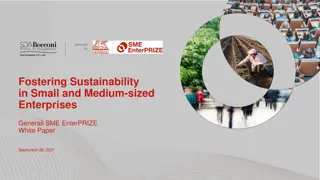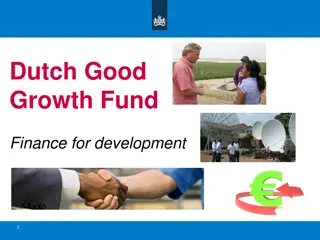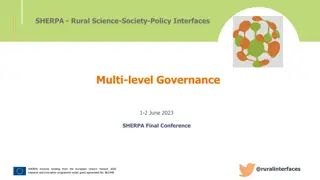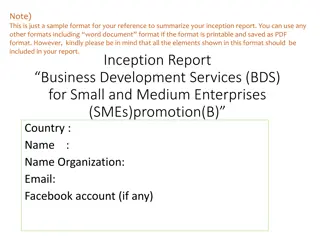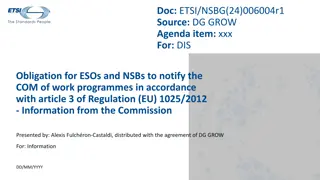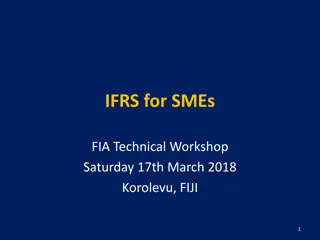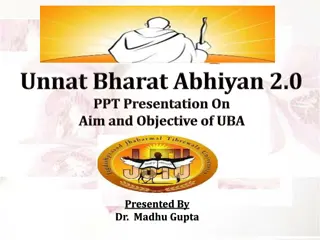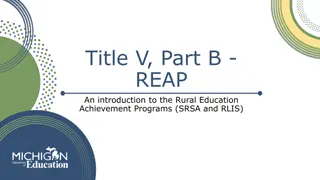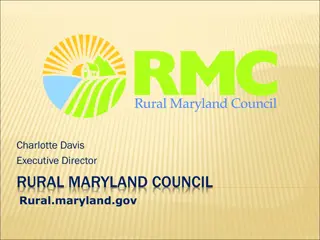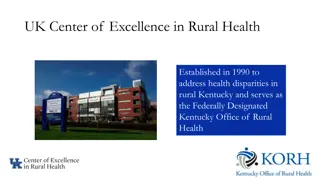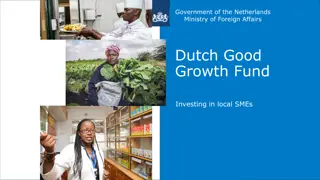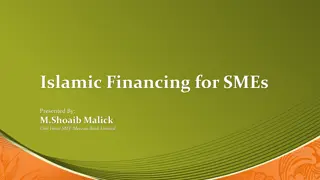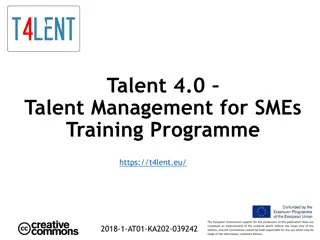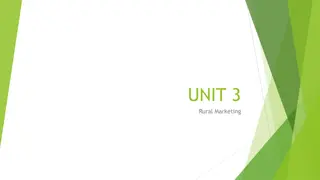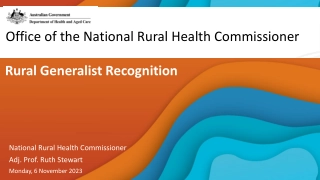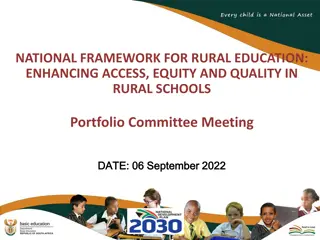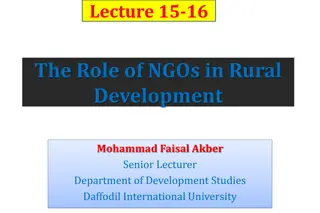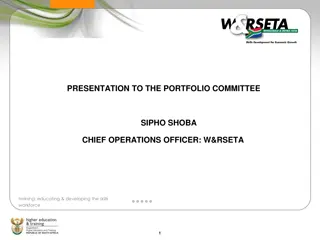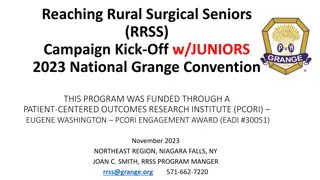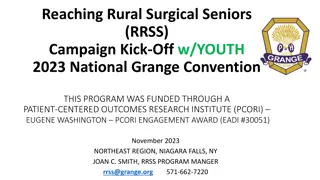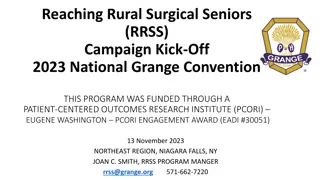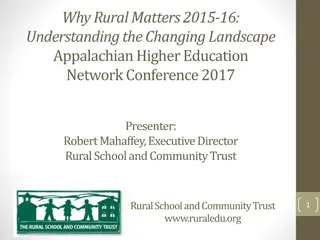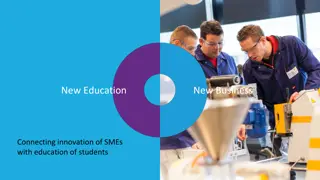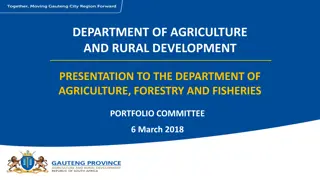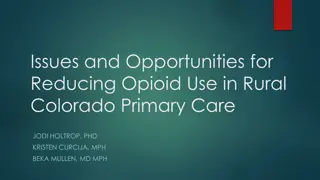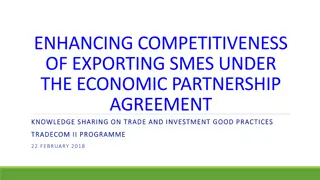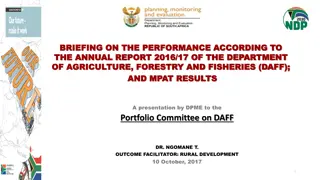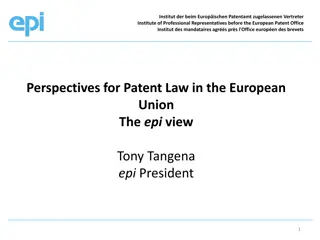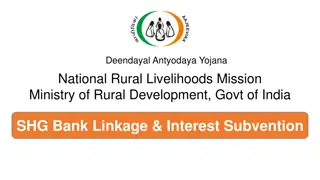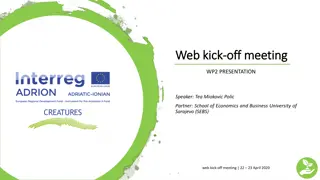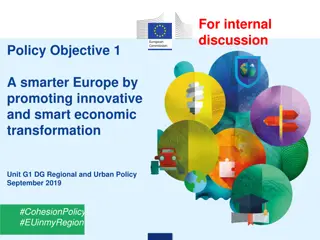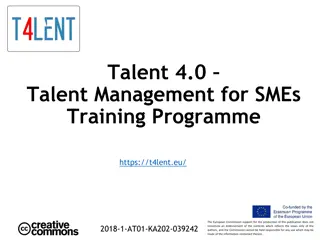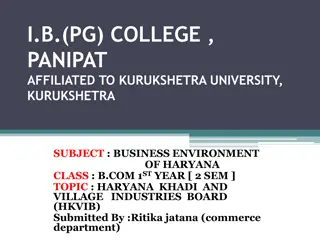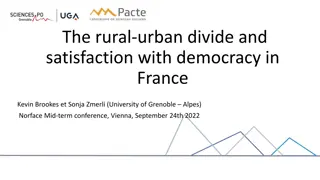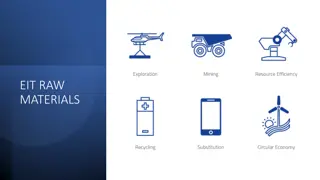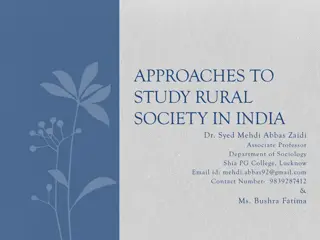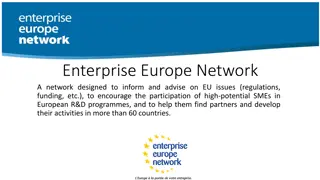Enhancing Collaboration Between ESOs and SMEs for Rural Development
Explore strategies to break silos between ESOs and SMEs, focusing on capital needs, donor relationships, and aligning incentives to improve collaboration and support for rural SMEs. Emphasize the transition to demonstrating value to investors and shared accountability for performance.
Download Presentation

Please find below an Image/Link to download the presentation.
The content on the website is provided AS IS for your information and personal use only. It may not be sold, licensed, or shared on other websites without obtaining consent from the author. Download presentation by click this link. If you encounter any issues during the download, it is possible that the publisher has removed the file from their server.
E N D
Presentation Transcript
Reaching Rural MSMEs SF partner gathering 2024 March 2024
Reaching Rural: co-learning sessions Session 1 - AM 27th Feb 2024 (partners and staff) How do we break silos between ESOs and SMEs to support collaboration? (facilitated by Sam Ndonga, Samawati Capital) How can we move towards a common set of metrics to benchmark approaches to supporting SMEs, stimulate learning and improve outcomes? (Mark Blackett, AMEA) How are we engaging the energy and ideas of young people as agents of change? (Nono Sekhoto, ALA) Digitally enabled collaboration for rural SMEs and practical tools for convening rural SMEs (Alex Simuyandi, Emerald Africa) What metrics can help us see the broader changes occurring at the community/ecosystem level through the collaborations of many individuals and organisations? (Nadia Martinez, SAFIN) Session 2 PM 27th Feb 2024 (partners, funders & staff) How are we ensuring rural SMEs are receiving the support they need? (Jessica Stewart, Creative Metier) Macro-economic dynamics and impact, electoral cycles (Val Wiggett, ALA) What is the role of networks and existing micro systems in reaching rural SMEs? (Nzwaki Adonisi, WAI) What are the financial innovations that are making a difference? (Nicholas Colloff, Argidius) Investment/financial products that are structured to address the needs of rural-impacting SMEs? (Deji Abedusoye, Sahel Capital)
How do we break silos between ESOs and SMEs to support collaboration? A lot of initiatives happening in the space, a lot more needs to be done Sustainability of ESOs More focus should be on capital needs of ESOs which are underfunded creates competition (staff, grant funding) not collaboration, distracts from focus on quality TA ESOs often deliver results to donors and not SMEs or SMEs how to change the customer as donor to SME or investor? Specialisation of ESOs to build trusted relationships with investors Need to demonstrate value of TA to investors to pay for it and collaborate Transition to understanding value Investors may not know ESOs and what they do, who is delivering high quality TA and may have limited funding to pay for it Aligning incentives between ESOs and investors shared accountability on performance and sharing in financial results
How can we move towards a common set of metrics to benchmark approaches to supporting SMEs, stimulate learning and improve outcomes? 1/2 Ideas: This group could and should do more Survey donors/funders to understand their reporting requirements and work Stimulate dialogue at SME and donor level Some platforms that already exist that we can use to give visibility of SME needs, ESO offers, and donor requirements Need to create a regional SSA platform What already exists? But for any platform: Who funds it? Who operates it? How good is the data? How do SMEs report if do not have the data? Issues: Lots of people / BDS providers piling in around same MSMEs Given segmentation, how are we supposed to benchmark? Segment bottom up based on needs But standardisation from top down for donors [see next slide for examples cited] From SME side struggling to understand the ESO programmes and where should invest time Attribution of impact is always an issue Context is critical Many programmes will run and will never see the data lack accountability and transparency
How can we move towards a common set of metrics to benchmark approaches to supporting SMEs, stimulate learning and improve outcomes? 2/2 I&P: For all SMEs use: Core metrics used by: 2X Challenge standardised around key metrics: women in shareholding women in management women in employees products and services specifically focused on women AMEA: Jobs Turnover Access to finance Turnover Jobs created Capital raised Repayment rate 60DB reminder to focus on experience of SME ISFA: For agri businesses: Keep it simple and basic Turnover Jobs Capital raised SHF reached Indirect people reached Starting product core insights. 10-15 questions that any business would find useful. Attribution an issue some SMEs have been through several programmes and all claim credit for capital raise, for example. e.g. Has your quality of life changed? Can you describe that change to me? Chance of positive bias but can look at that further e.g. Have you experienced challenges?
How are we engaging the energy and ideas of young people as agents of change? Adapting to the world that youth face, even if we don't work directly with youth Intergenerational exchange important and should be focused on different ways of engagement when working with youth: Youth need structures and support - most doors seem slammed in their faces Peer to peer works well Creating safe spaces to enable cohort learning from one another Giving responsibility early Using passion to drive work forward Using data to unlock new ways of working Often a low (financial) cost required to invest in youth examples of opportunities at $1-2k that spur huge changes. Meaningful youth engagement is difficult: there are skillsets required to give a rigorous and structured way of how youth opinions/experiences are valid and contextualised. Meaningful engagement is often linked to work that is driven by and for youth. Recognising that youth are more likely to employ more youth through the businesses they establish Youth are often not starting from 0, but from a position of negative equity Mindset shift can be important in helping youth realise where opportunities lie: opportunities are not always visible.
Digitally enabled collaboration for rural SMEs and practical tools for convening rural SMEs Increasing Transparency Lot of Impact Investors with similar mandates, more transparency around who is providing what and when. Digitally providing this information would support collaboration among SMEs and Funds When Fund says no who can they refer them to Additional support like TA can be added on, broader set of value-add is also very important. Lots of report focused on research has been done but not all in one place. Investors can learn from the hurdles fintech s have faced, having a birds-eye view of what the industry needs. Digitisation & Sharing of SME data How can SMEs plug data into platforms which allow Investors to do DD (Impact & Financial data); how can SMEs be helped to plug this data. BDS providers working with SMEs, this role is expensive but can t be done by Investors. Validating & Gathering Accurate Market Data How SMEs serving the same market collaborate for synergetic impact. Creation of ESO hub to share data and learnings across the ecosystem. Bringing together BDS provider together to reduce repetition. How are local financial institutions integrated with the entire ecosystem? One defect of many interventions by INGOs and other funders is the lack of integration of local players; once they are part when the funders exit they have the understanding and knowledge. Particularly on the small lenders (especially where the SMEs are). Need to collaborate with partners to provide full set of information to rural SMEs and SHFs Digitisation can help reduce the cost of TA interventions and even financing of SMEs. Lessons on how to keep rural SMEs engaged, IoT allows companies to gather data (rural energy), in Agtech the physical (logistics & infrastructure) is more important. Important to focus on commercial viability (business model).
What metrics can help us see the broader changes occurring at the community/ecosystem level through the collaborations of many individuals and organisations? Understanding Broader Changes: The discussion aimed to identify metrics to assess the broader changes occurring at the community/ecosystem level through collaborations among individuals and organisations. Challenges in Measurement: Several challenges in measuring broader changes, including issues related to data confidentiality, competitive dynamics, and the complexity of capturing systemic impact. Additionally, the importance of time in assessing system change and the need to combat linear thinking imposed by donors were highlighted. There is difficulty in establishing metrics that can effectively capture the diverse objectives of network members, emphasizing the complexity of aligning metrics across varied organisational goals. Data Collection Strategies: Given the diverse nature of member organisations and their varied impact metrics, each member to measure what matters most to them and then finding ways to collate and aggregate this data effectively. Engaging with beneficiaries and partners, creating data platforms, and leveraging existing networks were highlighted as potential strategies to facilitate this process. Impact Stories: Participants stressed the importance of impact stories as valuable tools for capturing qualitative insights and illustrating the broader changes occurring at the community/ecosystem level. Need to collect both positive and negative stories to inform decision-making and celebrate success effectively. Qualitative stories were identified as a viable alternative approach to measure impact. Collaborative Approaches: Significance of collaboration in developing and implementing measurement strategies. Sharing learnings, facilitating peer learning groups, and exploring collaborations to avoid duplication were identified as key actions moving forward. Action Points: Continued dialogue on this topic is crucial. Actors at high leverage points should lead discussions to potentially establish standards or metrics for community-level impact measurement. Facilitators like SF are key players who could drive these conversations forward. Participants expressed a commitment to ongoing collaboration and knowledge-sharing to address the challenges associated with measuring broader changes at the community/ecosystem level.
How are we ensuring rural SMEs are receiving the support they need? Exercise caution around being prescriptive; leave space for flexibility; support should be customised Build on what is there and where SMEs are Local support providers are less expensive; understand the context better Case to be made e.g. to some financiers Lack of trust of local ESOs can be an issue Closer integration between FS providers and the ESOs required Advocate around enabling environment infrastructure (roads, electricity) important part of needs ESOs themselves are often start ups and require their own TA Need to take longer-term view of building skills and capability in local contexts This requires appropriate resourcing Need qualitative data to determine the effectiveness of the BDS Need for a platform for ESOs to communicate what they need But how do you bring it all together. Data, people with resource, people w need, policy and reg, and those who can implement
Macro-economic dynamics and impact, electoral cycles Themes Stakeholder management /more lobbying by partners Bridge financing and regulation Bailout/Relief/Liquidity Funds should be ongoing and more proactive. Alternative local currency instruments to mobilize domestic capital Proactive planning to mitigate some of the challenges. Dynamics African countries having elections in 2024 (20%) What can we do to enable SMEs to overcome some of the challenges affecting SMEs or thing about that are currently affecting SMEs? Spending Corruption Import-Export influences Engage financiers to go bit deeper during election years, slow down in the economy, affects fundraising cycles. Get an understanding of the fundamentals and underlying dynamics. Bridge financing for SMEs or Investors providing guarantees to banks At national and local level laws to protect SMEs Period of Uncertainty Not to be dependent on government but policy decisions affect SMEs. Various demands on international funding (competing interests like Ukraine & Gaza) uncertainty in the US agency funding budgets Engaging more local capital (Pension Funds) Bringing futures/foresights in our thinking, more planning
What is the role of networks and existing micro systems in reaching rural SMEs? Framing: Systems change anchored around how to tangibly reach to those who are not connected to the system, yet, we inevitably end up reaching within the same group of people. How do we continue/expand engagement? How can we engage with one another in microsystems? What is preventing us from reaching further? Language can be prohibitive/exclusive Building trust is central need to trust that those we support know their work better than us Working from a bottom-up approach is important: identifies what works and what doesn t, and allows funders to see what structure/networks are already working Need for skills in the market: e.g. foresight, network practice, community building, systems. They allow us to bring in actors who don t yet have a seat at the table to influence their future Have to recognise the role of government and international partners: can see what we can t and offer an opportunity to create change at scale. Have to recognise the power and value of changing mindsets around certain challenges: MPESA vs banking in Kenya, or shifting the role of development from NGOs to SMEs Ground your work in meeting people where they are Creating spaces/conducive environments for change open to many pathways. Recognise that decisions are being made about what a good future looks like and that who decides what that future is is an important question to bear in mind regarding funding decisions. Valuing trust and social capital: need to create ground for people to access their pathway to reach what they want.
What are the financial innovations that are making a difference? Financial Innovations Making a Difference Incentivising Banks: Aceli's approach of offering guarantees and origination incentives has successfully incentivised lending institutions to support agricultural value chain actors, resulting in significant growth in agricultural loan books. Effective Policy Interventions: Examples from Tanzania and Ghana demonstrate the impact of policy initiatives in driving financial innovation. Tanzania's allocation of $400M for local currency loans in agriculture and Ghana's incentivizing pension funds to invest beyond treasuries have spurred increased lending and investment in key sectors. Segmentation for Targeted Investments: Nicholas emphasised the importance of segmentation within the sector to drive targeted investments. By understanding different sectors, sizes, and growth trajectories, institutions can better target specific segments and optimize their impact. Working Capital Facilities: Sam highlighted the significance of working capital structures collateralised against commodities, providing businesses with access to much-needed capital for growth, without the traditional requirement of fixed assets for collateral.
Investment/financial products that are structured to address the needs of rural-impacting SMEs? Rural SME needs Local currency funding Collateral to access bank financing Not available Hedging costs are expensive to bear Market access customers, buyers, Affordability high interest rates, because perceived as higher risk Flexibility adapted to seasonality, timing and terms Needs for diverse types of instruments Infrastructure and missing components of value chain People talent, struggling to attract and retain talent Regulation International companies price competition that crowd out local players Solutions? Side car TA Facility for portfolio companies - people (recruiting, headhunting, sales team, professional development, team development) Challenge ST fix of hiring, how to continue to pay for it Diverse group of donors and funds: investors to understand their role in the capital continuum for different types of SMEs Facilitate ecosystem connections and collaboration Collection of financial data using data to create more innovation Collaboration to access data Complementary financial products to manage risk like insurance Alternative credit scoring Collaboration across stakeholders; LT view to grow SMEs Regulatory restrictions on collateral provisioning requirements IFRS requirements Credit risk guarantee collateral TA facility for hedging for local currency lending, reduce rate to match local interest rates Back-to-back facilities with banks Understanding the markets and being very specialised to target SMEs
Common threads Opportunities for: Facilitation of cross-ecosystem connection and collaboration Collaboration to collate and access data More segmentation to better appreciate SME needs Innovation around services that are appropriate to SME needs and contextual realities Clarity and aligned incentives between different functions of the SME ecosystem More engagement with (1) FSPs (2) donors around SME and ESO needs and realities Making the case e.g. around value of local service providers; advocacy to improve overall operating environment Appreciating and supporting a long-term view on supporting SMEs & the resources required for this



